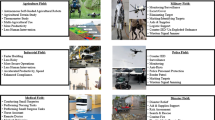Abstract
This paper focuses on the interaction and cooperation between two humanoid robots. In this research, Python language and NAO robot as hardware were used and based on Choregraphe, Webots and other simulation platforms, and through three experiments realize the interactions between two humanoid robots and the cooperation methods. This research used NAO's vision system, and then proposed the method of monocular-visional distance measurement to enable it determining the distance between the object and the target in the real time. The NAO arm is built by the module mainly using the DH method to formulate its forward kinematics and inverse kinematics formulas. This research also used the cloud platform protocols and models for cooperation communications, meanwhile used SOCK_DGRAM with UDP and WAMP (Apache + Mysql /MariaDB + Perl/PHP/Python) for their synchronization control and other aspects of their interactive use. Finally, we elaborated the experimental design procedure and demonstrated the simulation results and the effect of the real experiments.

















Similar content being viewed by others
References
Kajita S, Sugihara T (2012) Humanoid Robots in the Future. Advanced Robotics 23(11):1527–1531
Kuffner JJ, Lavalle SM (2011) Space-filling Treea: A new Persprective On Incremental Search For Motion Planning, Proceedings of the International Conference on Intelligent Robots and Systems (IROS). San Francisco, California, USA; IEEE, pp 2199–2066.
Kamei K, Nishio S, Hagita N et al (2012) Cloud networked robotics. Network IEEE 26(3):28–34
Kehoe B, Warrier D, Patil S et al (2015) Cloud-Based Grasp Analysis and Planning for Tolerance Parts Using Parallelized Monte Carlo Sampling. IEEE Trans Autom Sci Eng 12(2):455–470
Dogmus Z, Erdem E, Patoglu V (2015) REHABROBO-ONTO: Design, development and maintenance of a rehabilitation robotics ontology on the cloud. Robotics and Computer-Integrated Manufacturing 33(2):100–109
Pandey P, Pompili D, Yi J (2015) Dynamic Collaboration Between Networked Robots and Clouds in Resource-Constrained Environments. IEEE Transaction on Automation Science & Engineering 12(2):471–480
Too J, Tan C, Inamura T (2012) SIGVerse-A Cloud Computing Architecture Simulation Platform for Social Human- Robot Interaction, In: Proceedings of the 2012 international conference on robotics and automation, RiverCentre, Saint Paul, Minnesota, USA: IEEE
Wang L, Liu M, Meng QH (2015) Real-Time Multisensor Data Retrieval for Cloud Robotic Systems. IEEE Trans Autom Sci Eng 12(2):507–518
Li H, Jin M, Zou L (2008) A New Binocular Stereo Visual Servoing Model, IEEE Pacific-Asia Workshop on Computational Intelligence and Industrial Application. IEEE Computer Society 2008:461–465
Kehoe B, Matsukawa A, Candido S, et al. (2013) Cloud-based robot grasping with the google object recognition engine, In: IEEE international conference on robotics and automation. IEEE, pp 4263–4270.
Rodriguez MA, Buyya R (2014) Deadline Based Resource Provisioning and Scheduling Algorithm for Scientific Workflows on Clouds. IEEE Transaction on Cloud Computing 2(2):222–235
Cheng MY, Tran DH, Wu YW (2014) Using a fuzzy clustering chaotic-based differential evolution with serial method to solve resource-constrained project scheduling problems. Automation in Construction 37(1):88–97
Gautam A, Mohan S. A review of research in multi-robot systems, IEEE International Conference on Industrial and Information Systems. IEEE, 2012:1-5.
Kitano H, Asada M, Kuniyoshi Y, et al. RoboCup:The Robot World Cup Initiative, International Conference on Autonomous Agents. ACM, 1997:340–347.
Michel O. Webots: Symbiosis Between Virtual and Real Mobile Robots, International Conference on Virtual Worlds. Springer-Verlag, 1998:254–263.
Acknowledgement
The author deeply acknowledges Ms. Han, Xuejiao initial test support at first rough model.
Author information
Authors and Affiliations
Corresponding author
Ethics declarations
Conflict of interest
The authors declare that they have no competing interests.
Additional information
Publisher's Note
Springer Nature remains neutral with regard to jurisdictional claims in published maps and institutional affiliations.
Rights and permissions
About this article
Cite this article
Juang, LH. The Cooperation Modes for Two Humanoid Robots. Int J of Soc Robotics 13, 1613–1623 (2021). https://doi.org/10.1007/s12369-021-00753-1
Accepted:
Published:
Issue Date:
DOI: https://doi.org/10.1007/s12369-021-00753-1




